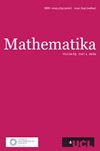加权四元形式的定量哈塞原理
IF 0.8
3区 数学
Q2 MATHEMATICS
引用次数: 0
摘要
我们通过哈代-利特尔伍德方法,推导出在非正弦局部可溶性假设下,某类加权四元数形式的积分零点个数的渐近公式。我们的多项式 F ( x , y ) ∈ Z [ x 1 , ... , x s 1 , y 1 , ... , y s 2 ] $F({\mathbf {x}},{\mathbf {y}}) \in {\mathbb {Z}}[x_1,\ldots ,x_{s_1},y_1,\ldots ,y_{s_2}]$ 满足 F ( λ 2 x 、 λ y ) = λ 4 F ( x , y ) $F(\lambda ^2 {\mathbf {x}}, \lambda {\mathbf {y}}) = \lambda ^4 F({\mathbf {x}},{\mathbf {y}})$ 。我们的结论改进了直接应用伯奇方法得出的结论。例如,我们证明在许多情况下,当 s 1 ⩾ 2 $s_1 \geqslant 2$ 和 2 s 1 + s 2 > 8 $2s_1 + s_2 > 8$ 时,预期的渐近公式成立。本文章由计算机程序翻译,如有差异,请以英文原文为准。

A quantitative Hasse principle for weighted quartic forms
We derive, via the Hardy–Littlewood method, an asymptotic formula for the number of integral zeros of a particular class of weighted quartic forms under the assumption of nonsingular local solubility. Our polynomials satisfy the condition that . Our conclusions improve on those that would follow from a direct application of the methods of Birch. For example, we show that in many circumstances the expected asymptotic formula holds when and .
求助全文
通过发布文献求助,成功后即可免费获取论文全文。
去求助
来源期刊

Mathematika
MATHEMATICS, APPLIED-MATHEMATICS
CiteScore
1.40
自引率
0.00%
发文量
60
审稿时长
>12 weeks
期刊介绍:
Mathematika publishes both pure and applied mathematical articles and has done so continuously since its founding by Harold Davenport in the 1950s. The traditional emphasis has been towards the purer side of mathematics but applied mathematics and articles addressing both aspects are equally welcome. The journal is published by the London Mathematical Society, on behalf of its owner University College London, and will continue to publish research papers of the highest mathematical quality.
 求助内容:
求助内容: 应助结果提醒方式:
应助结果提醒方式:


